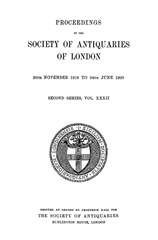No CrossRef data available.
Article contents
Thursday, 6th February, 1913
Published online by Cambridge University Press: 10 May 2010
Abstract

- Type
- Proceedings
- Information
- Copyright
- Copyright © The Society of Antiquaries of London 1913
References
page 46 note 1 Proceedings, xxiv. 108.
page 51 note 1 I print tbese words as originally written. But in the subsequent discussion it was pointed out by the President that there had been four handles or lugs at these points, not medallions. In view of this suggestion, which I readily accept, some subsequent statements require modification.
page 53 note 1 There are two of these bells in the tower of St. Just, the parish whence this vessel comes.
page 54 note 1 I have indicated in a previous note (p. 51) that the vessel must have originally had handles ; the Olney vessel therefore is not a parallel instance. Mr. Paley Baildon has also reminded me (v. infra) that a holy-water pot is a jug and not a stoup.
page 54 note 2 Antiquary, xxxiiij p. 272.
page 55 note 1 xv, p. 324 ; for the mortar see Arch. Journ. xlviii, pp. 206, 434.
page 55 note 2 East Anglian Notes and Queries, ix, p. 325, x, p. 69.
page 55 note 3 See generally Antiquary, xxxiii, pp. 243, 268, 338, 302.
page 56 note 1 Dalton, Treasure of the Oxus, 1905, plates v, xvii, xxix.
page 57 note 1 References in Proceedings, xxi. 138.
page 58 note 1 Iron Age Guide (British Museum), pp. 97, 53. figs. 48, 73, and pl. vi.


